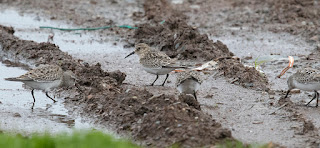Baird's Sandpiper causes more anxiety among Newfoundland birders than any other shorebird species. It is a very scarce migrant during the period 20 August to late September and occasionally up to mid October. It becomes a case of looking too hard at similar species, mainly juvenile Semipalmated Sandpipers with somewhat similar scaly looking upper parts. However, the real season of Baird's look alikes is in the latter half of October. Juvenile White-rumped Sandpipers are far more scaly on the upper parts than the Semi Sandpiper ever is. The juveniles start appearing in mid September but numbers really take off in mid Oct to mid Nov. Entire flocks of super scaly topped sandpipers are everywhere. They show up in odd locations for a sandpiper like parking lots, random lawns, roadways and of course kelp covered beaches. They become the dominant shorebirds species after the 3rd week of October.
If someone reports a Baird's Sandpiper in late October it is met with skepticism. Today 21 October 2018 I came across a nice flock of 38 White-rumped Sandpipers feeding around a wet area where manure piles are stored on Pipeline Road, Goulds (site of the June 2018 Sandhill Crane). The drizzle and south winds gusting to 80 km/hr likely grounded them. There were only two adults in the flock. the rest were spiffy juveniles. It seemed to be a pure species flock but then I saw one with a buffy upper breast walking toward me. This doesn't look right. Then it turned side on and I saw the buffy side of head and neck. That is all I needed to know this was a Baird's Sandpiper. Very unexpected. The late date was one thing but the fact that it was travelling with White rumps also seemed odd.
The immediate need was to get pictures. Although people generally trust my bird IDs there are some birds that no matter who you are one feels a lot better having seen the picture. It was not real close and the wind and blowing fog made for poor conditions but no excuse will do. I had only 20 minutes with the bird before the whole flock of birds vanished after a Mourning Dove flew in! Pointed wings like a Merlin I guess.
The Baird's Sandpiper in the middle has a more uniform scaly back pattern than the majority of juvenile White-rumped Sandpipers
The buffy neck and side of head of this Baird's Sandpiper is the best field marks when separating it from a White-rumped Sandpiper which is always grayish here.
The Baird's Sandpiper has a nice buffy breast with vertical pencils streaks that is cut off in an even line. The fresh plumage juvenile White-rumped Sandpiper on the right has an uneven lower border to breast streaking on a white-ish back ground. Juvenile White rumpeds show a variable amount of rufous edging to the scapulars. Baird's never show any rufous in the back but neither to do all White rumps. White rumps begin moulting out those red scapular feathers while in Newfoundland and replace them with plan gray feathers in preparation for the winter season. The presence of rufous eliminates Baird's but the lack of it is insignificant.
This picture shows the uniform scaly pattern of the Baird's next to two out of focus juvenile White rumps still with plenty of rufous showing in back.
The Baird's
A comparison of the buffy neck colour of the Baird's vs the gray neck of the juvenile White-rumped.
This is the same juvenile White rumped above and below. Note how new plain gray feathers have grown in replacing the rufous edged feathers during its juvenile stage.









We are trying to update the Georgia Ornithological Society database. Can you contact me at steve_holzman at yahoo.com?
ReplyDelete